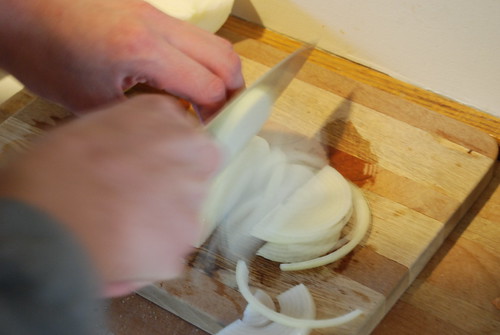 |
| Julienne your onions diligently. |
One quart of milk, six large onions, yolks of four eggs, three tablespoonfuls of butter, one and one half tablespoonfuls of flour, one cupful of cream, salt, pepper.This recipe is rather straightforward, given that it's about 50 years newer than some of my other sources; therefore there's not much that needs changing, and merely a few tweaks to make.
Put the butter in a frying pan. Cut the onions into thin slices and drop in the butter. Stir until they begin to cook, then cover tight and set back where they will simmer, but not burn, for half an hour. Now put the milk on to boil, and then add the dry flour to the onions and stir constantly for three minutes over the fire; then turn the mixture into the milk and cook fifteen minutes. Rub the soup through a strainer, return to the fire, season with salt and pepper. Beat the yolks of the eggs well, add the cream to them and stir into the soup. Cook three minutes, stirring constantly. If you have no cream, use milk, in which case add a tablespoonful of butter at the same time. Pour over fried croutons in a soup tureen.
For my version, I am doing the following:
Onion Soup
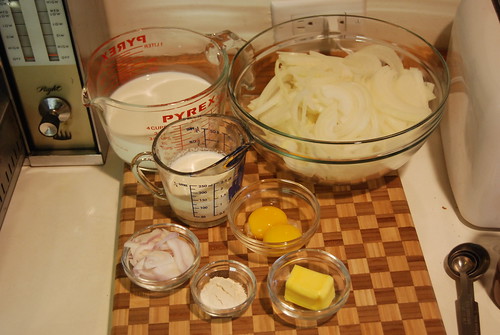 |
| Mise-en-place for this recipe. |
1 pint (475 ml) of milk
2 large onions, julienne (the modern large onion is larger than a 1926 large onion)
1 shallot, julienne
2 egg yolks
1 1/2 tablespoons (23 g) butter
3/4 tablespoon (6 g) flour
1/2 cup (119 ml) heavy (double) cream
salt and white pepper to taste
1. Warm milk, and melt butter over medium to medium-low heat in a large sauté pan (I use my sautoir.) Sweat onions and shallot in butter until soft. (Sweating is like a sauté, but slower and at lower heat. You want the onions soft, with no browning or sticking to the bottom of the pan.) At this point, it is helpful to have other tasks to do, or music to amuse you, as it will take a little while to get the onions nice and soft. Stir occasionally.
2. Add flour to create a roux, and cook for a couple minutes. (Remember roux? If not, see here.) The flour will want to stick to the bottom of your pan, so stir conscientiously and constantly.
3. Add onions to the milk, and simmer for 15-20 minutes, stirring now and then.
4. I don't own a food mill, and I don't want to try and press onions through a sieve. Therefore, I'm getting out my immersion blender, and taking it to the soup. (You'll get a very similar result to using a food mill/pressing the soup through a sieve, so if you don't have an immersion blender, don't worry. You don't have to run out and get it right now. Soon though. They're awesome.) Have a towel handy to protect your counter, person, and belongings from splatter if you're not careful. Keep the blender under the level of the soup, and it'll stay pretty clean. Get the soup nice and smooth.
5. Mix the egg yolks and cream, combining well. This is called a liaison, and it's one of the classical thickening agents for soups and sauces in French cuisine. It doesn't have a lot of thickening power, but it's enough to make this soup pull together a little more. Obviously, it contains raw egg product, and will therefore need to be cooked before you can serve it. So, add it to the soup and stir constantly for two to three minutes, simmering. (If you don't stir well, you'll end up with sort of a scrambled-egg texture... which isn't what you want.) Addendum: As Harriet, a commenter, noted—you could temper the egg mixture to avoid the scrambling; take your liaison and add one ladle-full of soup to the liaison, mixing well as you do. Add another ladle-full, mixing. This should bring the temperature of the liaison up a ways, and now you can add it slowly to the soup, mixing well as you do. Thanks, Harriet!
6. Season to your tastes with salt and white pepper (since this is a white soup, no sense in flecking it with black pepper bits.) Be gentle with the white pepper, it's very powerful stuff. Toast a piece of bread (in this case, some home-made whole wheat,) and place it in a bowl; ladle your soup over it. Sprinkle some chopped chives on top, or be fancy and braid them if you so desire (but chopped are easier to eat...) (Editor's note: I sadly don't have any chives in the house right now...)
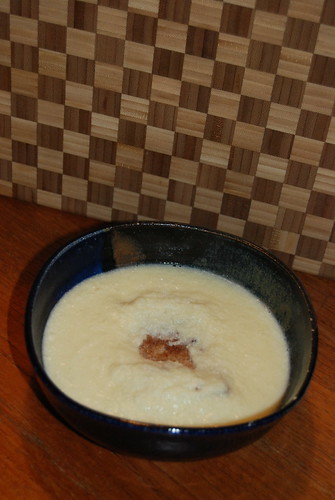 |
| And thus, soup. |
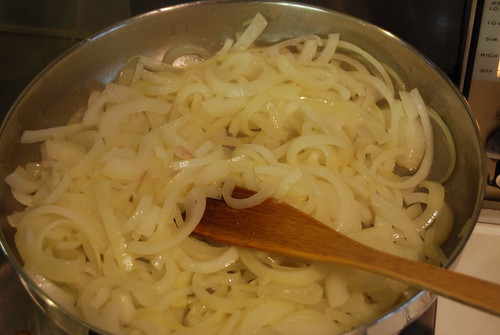
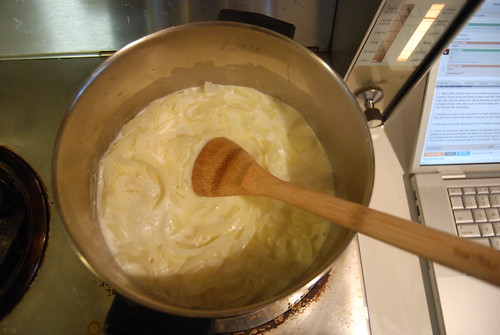
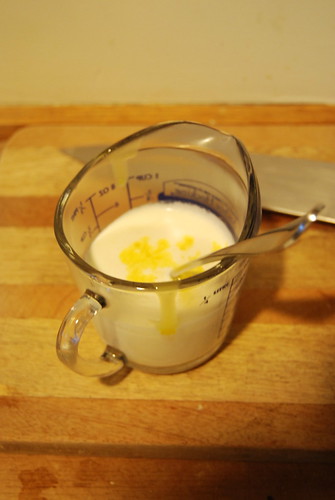
So it's basically a cream of onion soup. Huh. I didn't know about using egg yolks to thicken soup. Since I don't eat flour, that could be an interesting way to try to thicken a broccoli soup. What do you think, would that work?
ReplyDeleteDarkmagess—
ReplyDeleteThe Liaison is somewhat tricky to use, as it will want to scramble up rather quickly, and you'll be left with a very strangely-textured soup.
In this particular recipe, the flour is largely unnecessary, I think; most of the body of the soup comes from the puréeing of the onions and the addition of the liaison.
In soups in general, I (personally) would tend towards using arrowroot or corn starch to thicken them (at least slightly) if I couldn't use a roux.
The liaison adds richness with some amount of thickening, though not much thickening. It's definitely worth a try, though—it is used in a similar way in Egg Lemon soup... which I might have to make soon.
Would you recommend tempering the liaison with a bit of the warm mixture? I plan to let all ingredients come to room temperature anyway, but perhaps that might help avoid the scrambled egg problem.
ReplyDeleteTempering is definitely the best way to avoid the scrambling issue. I was sort of blinded by just following the recipe, and ignored my common sense which should have dictated tempering it. Well noted!
ReplyDeleteCurrently reading through the Whitehouse Cookbook myself and am always interested in seeing peoples interpretations of recipes. Keep up the good work!
ReplyDeleteOh, I can't wait to get back to my kitchen and try this! My partner loves creamy soups and I'd never even eaten a white soup until I met her, so this should be great. Thanks!
ReplyDelete